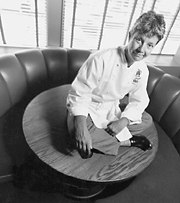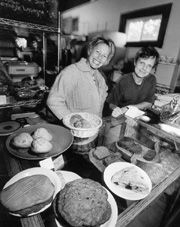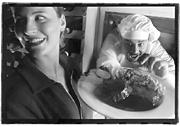Perhaps one day obstetricians will include in their routine advice to new parents a word about their swaddled newborn’s sexual orientation. “There is a statistical chance your baby is a homosexual,” the doctor might inform the parents. He or she might explain that although the genetic basis for homosexuality remains to be established, the increasing weight of scientific evidence for it squares with the experience of many lesbians and gay men who believe
they were born that way—or, at least, never chose their homosexual orientation. The doctor might ask if the couple has any questions or issues that will stand in the way of their being able to provide the extra support their child will need in navigating the turbulent waters of sexual minorityhood.
A remarkable number of parents of gay kids speak wistfully of this talk they never heard. “I would describe myself as a typical parent, in that I never considered the possibility that one of my children would be gay or lesbian,” says Bob Fitzgerald, a retired United Church of Christ/Congregationalist minister whose son came out to him at 22. “I was not a name caller, not a putter-downer. It just never came up. Which is about as bad a situation as any for a gay child. It may not be hurtful, but it’s no friend.”
Fitzgerald, who is an active member of the support group Parents, Friends, and Family of Lesbians and Gays (PFLAG), continues emphatically: “Here’s what I’d like to say to a whole roomful of parents: ‘Assume that you have a gay or lesbian child.'”
Where would such an assumption lead a parent? Is there a special set of rules for raising kids who are gay? How can a heterosexual parent be sufficiently sensitive to the unique developments of gay identity? It is worth noting that social science researchers know a great deal about the developmental stages of growing up gay within a disapproving society, but know almost nothing about gay development on its own terms.
A disapproving society, indeed, is the one near-constant of a gay child’s experience. Following our newborn through his childhood and adolescence, here is what loving parents must know about growing up gay to ensure that alienation and loneliness aren’t the only aspects of their child’s experience.
As the baby grows, he might feel different from everyone else in relatively short order, as gay and lesbian adults frequently claim in retrospect. “Most gay youth will recall a sense of being different that’s pre-sexual,” explains Dr. Gary Remafedi, an associate professor of pediatrics at the University of Minnesota who researches gay youth. “This may manifest in gender nonconforming behavior. Boys may not be interested in sports. Girls may be more tomboyish. Or it may be just a vague sense of difference.”
In 1993, a 70-year-old California grandmother named Mary Ann Cantwell became fascinated by the concept of self-awareness in childhood after her adult gay son, Mike, told her he felt different from the age of 5. For her book Homosexuality: The Secret a Child Dare Not Tell, Cantwell unscientifically polled nine gay men and 11 lesbians on the question of when they had their first inkling. The average age among them was 6 and a half. One man told his father when he was in kindergarten that he wasn’t like the other little boys in his class. Another knew at 5 that he’d be better off whispering his career aspiration—hairstylist—to his teacher than announcing it before the class.
Mark Iversen, a gay 19-year-old student at South Seattle Community College, knew he was not like his playmates in the Kent School District before he knew why. “In fourth through sixth grade while the other kids went to recess I was the only boy to be bookshelf-keeper,” Iversen recalls. “I liked jump-roping with girls instead of football.”
But how dependable an indicator of homosexuality is gender nonconformity? “The answer is, we don’t know,” says Dr. Anthony D’Augelli, a professor of human development at Penn State who specializes in gay development. “One of the most durable findings of the research is that gay and lesbian people, especially males, remember a more gender-nonconforming early childhood than heterosexuals do. The other way around, though—that most effeminate boys will be gay—we have not found to be true.” Dr. Benjamin Spock, in his perennial best seller Dr. Spock’s Baby and Child Care, assures parents that “the majority of [gender nonconformists] will grow up to be heterosexual.” According to this voice of pediatric wisdom, however, it’s all in the degree. “If a girl wanted to play a lot with boys and occasionally wished she were a boy, but also enjoyed playing with girls, I wouldn’t be concerned,” Spock writes. “If she would play only with boys and was always unhappy about being a girl, I’d want a [psychiatric] consultation.”
So strongly correlated are the two that theorists have long pondered the possibility that gender nonconformity may even be a cause of homosexuality. In his study on male homosexuality, psychoanalytic theorist Richard Friedman concluded that effeminacy indeed leads to gayness, a philosophy held today by some who believe that homosexuality is a social construct and can be unlearned. “You can have a very, very young child who displays traits that are labeled as effeminate,” observes Dr. Jeffrey Santinover, a Connecticut psychiatrist and author of Homosexuality and the Politics of Truth, a book that lays out a case for homosexuality as an acquired and changeable, as opposed to genetic, condition. “If you take a child like that and frame those traits as a bad thing because you believe boys shouldn’t be delicate and sensitive, it will increase the risk that those effeminate traits will result in homosexuality. If those traits are praised and validated as a different form of masculinity, he’ll grow up to be a delicate, sensitive, possibly even effeminate man who is not a homosexual.”
Santinover further opines that highly intelligent young boys are thus likeliest to become gay, since smart boys are more likely to be interested in the life of the mind than the vigors of stereotypical masculinity. Here it should be noted that the politics around the issue of gay children is so highly charged that the research (on both sides) can look suspiciously agenda-driven. Indeed, Santinover’s views are anything but widely held among researchers, most of whom are persuaded by recent biological research suggesting a strong genetic basis for homosexuality. Yet his views are held in high esteem by groups like Seattle’s Metanoia Ministries, a nondenominational Christian organization dedicated to “reparative therapy” for homosexuals who want to be straight.
Metanoia, explains director Robert Taylor, offers counseling and support groups for kids who need to “repair the dissociation from their same-sex parent,” which they believe causes homosexuality. Santinover says such reparative programs show a 50 percent success rate.
Does this mean, then, that a supportive parent should encourage reparative therapy? Most lesbians and gays and their advocates recoil violently at the idea. Not only do they challenge the 50 percent success statistic, they cite the American Psychological Association’s 1990 pronouncement against reparative therapy. Even Santinover agrees that it would be unethical to force a person into therapy he or she does not want.
“Parents often come to me asking if they change their child’s patterns of play, will that change the sexual orientation,” says developmental and clinical psychologist Ritch Savin-Williams, a professor at Cornell who specializes in the development of sexual identity. “We have no evidence that that’s true. If a person can create a gay kid, we have no idea how.” The University of Minnesota’s Gary Remafedi adds that there exists no evidence that gender-nonconforming behavior can be changed. “There’s very little a parent can do to alter a child’s mannerisms,” he explains. “A child won’t get it. If a boy wants to play with dolls and you won’t let him, he’s left feeling bewildered and unaccepted, not inspired to change.” Spock weighs in with a similar warning: “I think it is normal for little boys to want to play with dolls and for little girls to want to play with toy cars, and it’s quite all right to let them have them. If a father anxiously turns down his son’s request for a doll—or otherwise shows his worry that the boy has ‘girlish’ tastes—it doesn’t reinforce the child’s masculinity. It gives him a sense that his own and his father’s masculinity are doubtful or inadequate.”
The price of parental opprobrium of nonconforming behavior can be alarmingly high. Mary Griffiths, a Bay Area mother of four who couldn’t reconcile her son Bobby’s homosexuality with her devout Christianity, tried everything in her power to change his apparent homosexual orientation. From the time Bobby was a little boy, she discouraged his feminine mannerisms, chiding him vehemently after he sashayed over to the neighbors’ in his sister’s half-slip, and riding him not to flip his hair back with what she saw as feminine flourish. Her prohibitions didn’t work, and after Bobby reluctantly came out as a teen, she enrolled him in counseling and assured him that God would transform him.
No keener about his orientation than his mother was, Bobby gamely tried to change. He had always been an exceptionally obedient child—a trait experts agree is common among gay children who frequently try extra hard to be good. His nature, however, kept reasserting itself. As chronicled in the extraordinarily moving 1995 book Prayers for Bobby, Bobby kept a diary in which he vented his desperation and mounting self-loathing. In October 1982, the 19-year-old wrote: “I’m determined to win over the evil . . . I’ll kill the evil force within me. I will kill the evil force within me. I will stop you.” A year later he killed it for good, leaping off a freeway overpass into the path of an oncoming semi.
Mary Griffiths is now a gay-rights activist with a simple message for parents: Accept your children for who they are.
But what does this really mean for parents? Experts caution that acceptance should remain open-ended, because sexual identity fluctuates. “I think it’s very important not to leap to overidentifying someone from same-sex sexual or affectional behavior, or crushes,” says University of Washington sociologist Dr. Pepper Schwartz. “Girlfriends having sexual play is so common. Boys, interestingly, may overidentify themselves before you do. So you have to be a sane voice to this child.” A friend of Schwartz’s had an 8-year-old son who liked to grab and kiss other little boys. One day he said to his mother, “Do you think I’m gay?” “Instead of dragging him off to a psychoanalyst or a priest, this woman said, ‘I don’t think you can tell right now. And if you are gay, I’ll love you.’
“Defining people is an extremely powerful act,” Schwartz continues. “It’s really best to just be supportive of people as they find their way. I’d never say to dismiss an intense feeling of love and attachment in a child. I’d respect and believe it. I just wouldn’t give it a period at the end of the sentence.” Researchers roundly agree that it’s good for kids not to have to label themselves. “Confusion is what adolescence is all about,” says Savin-Williams. “The rigidity is the destructive part.”
Loving a child, in other words, doesn’t mean embracing a label. This is something all good parents know instinctively; something that applies to raising gay kids, straight kids, and every kid in between. “One thing is true and constant: Kids are kids,” advises Randall Cole, communications coordinator for New York’s Hetrick-Martin Institute, a social service agency serving 8,000 gay and lesbian youths a year. “Parents frequently come to us asking, ‘How shall we change our parenting to raise our gay child?'” These folks need to be warned of the social censure and attendant physical risks their gay children will face, Cole allows. But aside from this, “We tell them there is no equation that needs to be altered to raise a gay child.”
Instead, conscientious parents (of gender nonconformists in particular) will want to look out for behaviors that may signal the pressures attendant to growing up gay. By about age 10-12 the child will begin to realize that his “difference” is sexual; a concept that will likely confuse or terrify him. The child may deny it to himself; a denial that D’Augelli has observed frequently takes the form of vigorous heterosexual activity. At some point the realization becomes overwhelming, and the child finally says to himself, “I’m gay.” The average age for this self-identification, which in the 1970s was the young adult’s twenties, has plunged in recent years to the tender age of 13 and a half.
High school will likely be the toughest time for a sexual minority, who is statistically at higher risk of ostracism from peers, drug abuse, dropping out, and suicide. (One Kent youth, the aforementioned Mark Iversen, suffered such verbal and physical abuse at the hands of his classmates and teachers that he and the ACLU have filed a suit against his Kent high school for failing to protect him.) Until the child opts to come out to his parents—average age: 18—parents are best advised to maintain a home environment where the child feels free to broach the subject. Sometimes parents bring it up; a tactic Savin-Williams favors within boundaries (not, ‘You’re not gay are you?’). Fitzgerald, who left sexually informative books and magazines around the house when his kids were adolescents, now wishes he’d thrown in a copy or two of the Advocate. “This approach allows the child to remain private if they want to,” Fitzgerald explains. “Asking outright felt too confrontational to me. But kids need a context in which they feel they can say more.”
Once parents know about their child’s homosexuality, they can be counted on to move through a series of predictable emotions. Guilt is a big one—for what they might have done to “cause” it, for what they may have done to make things harder for the kid, for wishing it weren’t true. No matter how progressive the parent, most polled honestly would probably prefer straight kids—if only to spare them the inevitable pain of sexual minorityhood. Very often, a parent’s first reaction is about himself: from mourning dreams of grandchildren to fretting about what the neighbors will think.
Not surprisingly, the most persistent advice from experts is to let acceptance preempt every one of these messages. Exhibiting love and fostering open communication are the top two counsels, as it turns out, both from those in the “reparative therapy” camp and those who see homosexuality as natural. “Parents ought to make it crystal clear that no matter what happens they will love their child, they will stand by him, that nothing at all will cause them to leave the child—then they must take the time to show it,” recommends Santinover.
The universe of children, after all, is not divisible along one bright line, gay vs. straight. Instead there are a million lines, a trillion, dividing and connecting children along the filaments of each one’s nascent individuality. “My advice for raising a gay child is the same as it is for raising any child,” offers Mary Ann Cantwell (author of Homosexuality: The Secret a Child Dare Not Tell), whose gay son, Mike, was one of 10 children of hers. “Respect who the child is. If the boy wants to take tap dancing or the girl wants a football for Christmas, accept it. All children arrive with their own little suitcase of characteristics. They’re not blank tablets.
“People say to me, ‘Didn’t you know Mike was different as a child?’ Well, sure I did,” Cantwell muses quietly. “I knew all the kids were different.”







